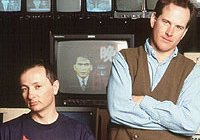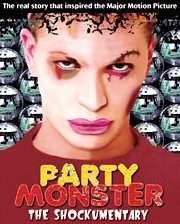and the return to the big screen of that Home Alone brat • page 2 of 2


 Together they give their new film a strong authenticity. Bailey, Barbato and St James were actually there through the Club Kids scene, and they tell it like they saw it ... with some editorial licence. (The New York Times reported that novelist Paul Auster’s son Daniel plead guilty to involvement in the murder, and yet he’s not mentioned in either the documentary or the feature.)
Together they give their new film a strong authenticity. Bailey, Barbato and St James were actually there through the Club Kids scene, and they tell it like they saw it ... with some editorial licence. (The New York Times reported that novelist Paul Auster’s son Daniel plead guilty to involvement in the murder, and yet he’s not mentioned in either the documentary or the feature.)But all the drugs and partying don’t seem to have blunted their memories at all. The film is full of telling details about the scene. As Randy puts it: “This was an important time in the New York scene and it’s a period that hasn’t really been written about much. These kids were obsessed about the cult of celebrity in a prophetic way, a way that’s absolutely relevant to the world in which we live today. The majority, not all of them, are successful artists today.”
Fenton adds that “in a way Club Kids were sort of Warhol’s children and they lived out that whole ideal of inventing yourself, that Rocky Horror thing: ‘Don’t dream it, be it!’ It was the final chapter in that whole New York creative nightlife scene that began with Studio 54. This is the scene that gave us Blondie, Madonna, RuPaul, Dee Lite ... and Club Kids was the cherry on that particular cake.”
And it’s Seth who starts peeling back the darker side of the scene, noting that all of these kids were social misfits who were reviled in one way or another, then tried to create a world where they could be superstars. “Were there scenes like that still in existence I think you’d see a little less of the violence in schools,” he notes.
“We were going to do away with sexual roles,” St James explains. “Drag was going to be the norm. Drugs were going to be this gateway into this utopian society.”
And after toying around with acid and cocaine, the Club Kids discovered their perfect high in the party drug ketamine hydrochloride, the animal tranquilliser better known as Special K. While Culkin and Green had never done K, they had plenty of help to get it right, most notably in the video footage of Alig and St James cooking and doing the stuff.
St James believes that if there’s ever been an anti-drug movie this is it. “But there’s a heart at the centre of it,” he says. And Fenton agrees that the film is essentially a morality tale, although it’s told without any moralising.
“It’s a portrait of what happens when people get what they’re wanting,” Seth says.
“The characters seem for a lot of people unreal or despicable,” Randy says, adding quickly, “No offence, James! But they actually are real people and they are good friends of ours. And some of them, James excepted, lost their way. And so this film is absolutely a morality tale, bit it’s one that I don’t think is traditionally told, so for many people I think it’s going to be a difficult film to find the heart of. But it’s there.”
And Fenton agrees that this is why they made the film to begin with. “Every time someone sets out to create a utopia, history has shown it always goes horribly wrong. With the best of intentions they end up creating a worse hell than the one they’re turning their backs on.”
“Yeah,” James continues, “we were trying to create a world where there were no rules and then when we learned that you can’t live without rules without, you know, absolute chaos. You know, the lines on the road are there for a reason.”
And it all came crashing to an end on that day in March 1996 when Angel Melendez’s dismembered body washed up on Staten Island.
So is the party over? “I’m an old spinster now,” James says with that evil glint, “but as for the party going on, well tonight the party will happen here!”


Note: A shorter version of this article, taken from the same interview material, was published in QX Magazine, 15 October 2003.



